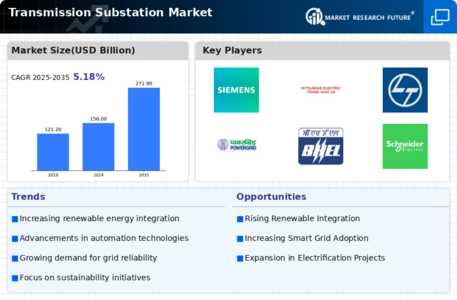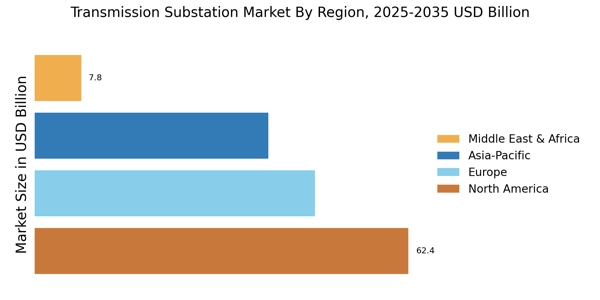Rising Demand for Electricity
The increasing demand for electricity across various sectors is a primary driver for the Transmission Substation Market. As urbanization and industrialization continue to expand, the need for reliable and efficient power distribution becomes paramount. According to recent data, electricity consumption is projected to rise by approximately 2.5% annually, necessitating the enhancement of transmission infrastructure. This surge in demand compels utilities to invest in new substations and upgrade existing ones to ensure stability and reliability in power supply. Consequently, the Transmission Substation Market is likely to experience significant growth as utilities strive to meet the escalating energy needs of consumers and businesses alike.
Government Initiatives and Investments
Government initiatives aimed at modernizing energy infrastructure significantly influence the Transmission Substation Market. Many countries are implementing policies to enhance energy security and promote sustainable practices. For instance, substantial investments in transmission infrastructure are being made to support renewable energy integration and reduce carbon emissions. In some regions, government funding for new substations and upgrades to existing facilities is projected to reach billions of dollars over the next decade. Such initiatives not only bolster the Transmission Substation Market but also encourage private sector participation, fostering a collaborative approach to energy management.
Growing Focus on Renewable Energy Sources
The shift towards renewable energy sources is a pivotal driver for the Transmission Substation Market. As countries strive to meet their climate goals, the integration of solar, wind, and other renewable sources into the energy mix becomes essential. This transition necessitates the development of robust transmission networks capable of handling variable energy inputs. The International Energy Agency indicates that renewable energy capacity is expected to double by 2030, thereby increasing the demand for substations that can efficiently manage this influx. Consequently, the Transmission Substation Market is poised for growth as utilities adapt to the evolving energy landscape.
Technological Advancements in Substation Design
Technological innovations play a crucial role in shaping the Transmission Substation Market. The advent of advanced technologies such as digital substations, automation, and smart grid solutions enhances operational efficiency and reliability. These innovations facilitate real-time monitoring and control, reducing downtime and maintenance costs. Furthermore, the integration of artificial intelligence and machine learning in substation management systems allows for predictive maintenance, thereby optimizing performance. As utilities increasingly adopt these technologies, the Transmission Substation Market is expected to witness a transformation, leading to improved service delivery and reduced operational risks.
Increased Investment in Infrastructure Development
Investment in infrastructure development is a significant catalyst for the Transmission Substation Market. As economies grow, the need for reliable power distribution systems becomes increasingly critical. Many regions are witnessing a surge in infrastructure projects aimed at enhancing energy transmission capabilities. According to industry reports, investments in transmission infrastructure are projected to exceed several hundred billion dollars over the next decade. This influx of capital is likely to drive the construction of new substations and the modernization of existing facilities, thereby propelling the Transmission Substation Market forward. The emphasis on infrastructure development aligns with broader economic growth objectives, further reinforcing the market's potential.


















Leave a Comment